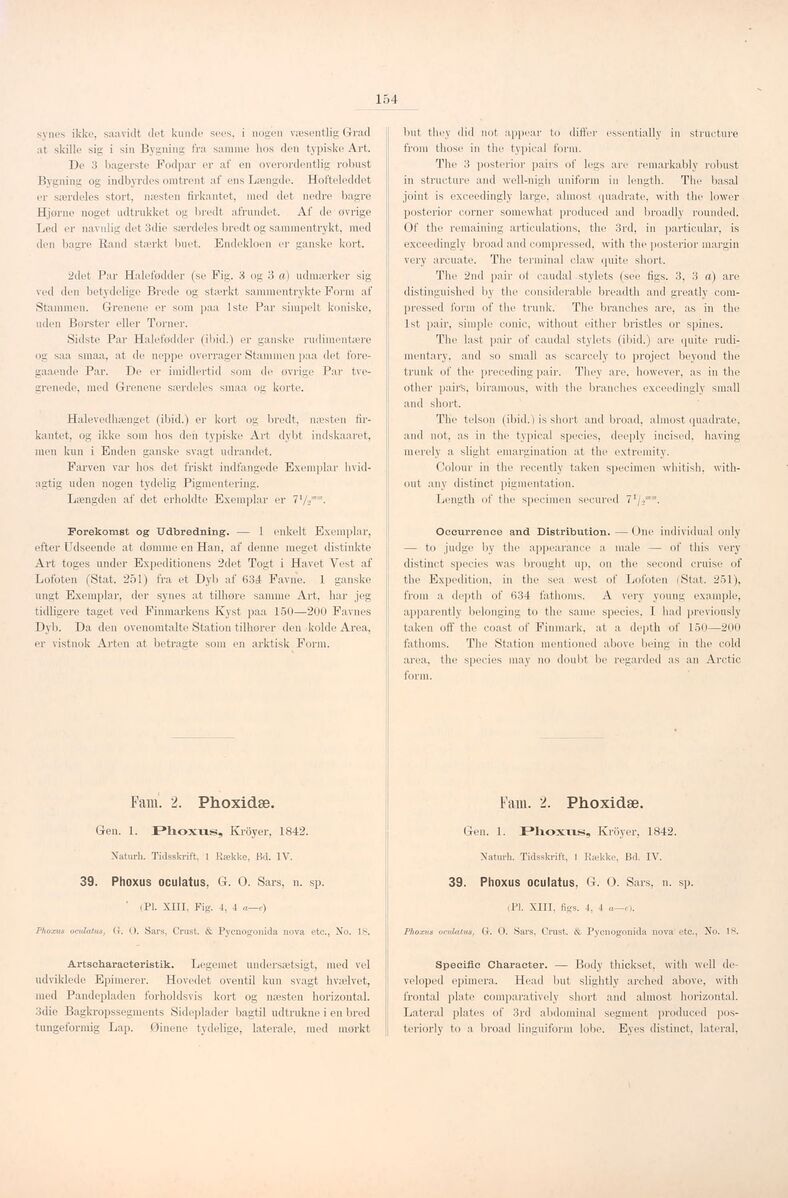
Full resolution (JPEG) - On this page / på denna sida - Sidor ...

<< prev. page << föreg. sida << >> nästa sida >> next page >>
Below is the raw OCR text
from the above scanned image.
Do you see an error? Proofread the page now!
Här nedan syns maskintolkade texten från faksimilbilden ovan.
Ser du något fel? Korrekturläs sidan nu!
This page has never been proofread. / Denna sida har aldrig korrekturlästs.
154
synes ikke, saavidt det kunde sees, i nogen væsentlig Grad
at skille sig i sin Bygning fra samme hos den typiske Art.
De 3 bagerste Fodpar er af en overordentlig robust
Bygning og indbyrdes omtrent af ens Længde. Hofteleddet
er særdeles stort, næsten firkantet, med det nedre bagre
Hjørne noget udtrukket og bredt afrundet. Af de ovrige
Led er navnlig det 3die særdeles bredt og sammentrykt, med
den bagre Rand stærkt buet. Endekloen er ganske kort.
2det Par Halefødder (se Fig. 3 og 3 a) udmærker sig
ved den betydelige Brede og stærkt sammentrykte Form af
Stammen. Grenene er som paa 1ste Par simpelt koniske,
uden Borster eller Torner.
Sidste Par Halefødder (ibid.) er ganske rudimentære
og saa smaa, at de neppe overrager Stammen paa det
foregaaende Par. De er imidlertid som de øvrige Par
tvegrenede, med Grenene særdeles smaa og korte.
Halevedhænget (ibid.) er kort og bredt, næsten
firkantet, og ikke som hos den typiske Art dybt indskaaret,
men kun i Enden ganske svagt udrandet.
Farven var hos det friskt indfangede Exemplar
hvidagtig uden nogen tydelig Pigmentering.
Længden af det erholdte Exemplar er 7V2""".
Forekomst og Udbredning. — 1 enkelt Exemplar,
efter Udseende at domme en Han, af denne meget distinkte
Art toges under Expeditionens 2det Togt i Havet Vest af
Lofoten (Ståt. 251) fra et Dyb af 634 Favne. 1 ganske
ungt Exemplar, der synes at tilhore samme Art, bar jeg
tidligere taget ved Finmarkens Kyst paa 150—200 Favnes
Dvb. Da den ovenomtalte Station tilhorer den kolde Area,
er vistnok Arten at betragte som en arktisk Form.
but they did not appear to differ essentially in structure
from those in the typical form.
The 3 posterior pairs of legs are remarkably robust
in structure and well-nigh uniform in length. The basal
joint is exceedingly large, almost quadrate, with the lower
posterior corner somewhat produced and broadly rounded.
Of the remaining articulations, the 3rd, in particular, is
exceedingly broad and compressed, with the posterior margin
very arcuate. The terminal claw quite short.
The 2nd pair of caudal stylets (see figs. 3, 3 a) are
distinguished by the considerable breadth and greatly
compressed form of the trunk. The branches are, as in the
lst pair, simple conic, without either bristles or spines.
The last pair of caudal stylets (ibid.) are quite
rudimentary, and so small as scarcely to project beyond the
trunk of the preceding pair. They are, however, as in the
other pairs, biramous, with the branches exceedingly small
and short.
The telson (ibid.) is short and broad, almost quadrate,
and not, as in the typical species, deeply incised, having
merely a slight emargination at the extremity.
Colour in the recently taken specimen whitish,
without any distinct pigmentation.
Length of the specimen secured 71/..™™.
Occurrence and Distribution. — One individual only
— to judge by the appearance a male — of this very
distinct species was brought up, on the second cruise of
the Expedition, in the sea west of Lofoten (Ståt. 251),
from a depth of 634 fathoms. A very young example,
apparently belonging to the same species, I had previously
taken off the coast of Finmark, at a depth of 150—200
fathoms. The Station mentioned above being in the cold
area, the species may no doubt be regarded as an Arctic
form.
Fam. 2. Phoxidæ.
Gen. 1. PlioxiiÄ, Krøyer, 1842.
Naturh. Tidsskrift, 1 Række, Bd. IV.
39. Phoxus oculatus. G. O. Sars, n. sp.
(Pi. XIII, Fig. 4, 4 a—e)
Phoxus oculatus, (t. O. Sars, Crust. & Pycuogonida nova etc., No. Is.
Artscharacteristik. Legemet undersætsigt, med vel
udviklede Epimerer. Hovedet oventil kun svagt hvælvet,
med Pandepladen forholdsvis kort og næsten horizontal.
3die Bagkropssegments Sideplader bagtil udtrukne i en bred
tungeformig Lap. Øinene tydelige, laterale, med mørkt
Fam. 2. Phoxidæ.
Gen. 1. I *lu»XHs, Krøyer, 1842.
Naturh, Tidsskrift, 1 Række, Bd. IV.
39. Phoxus oculatus, G. O. Sars, n. sp.
(PI. XIII, figs. 4, 4 a—e).
Phoxus oculatus, Gr. O. Sars, Crust. & Pycnogonida nova etc., No. 1K.
Specific Character. — Body thickset, with well
developed epimera. Head but slightly arched above, with
frontal plate comparatively short and almost horizontal.
Lateral plates of 3rd abdominal segment produced
posteriorly to a broad linguiform lobe. Eyes distinct, lateral,
<< prev. page << föreg. sida << >> nästa sida >> next page >>